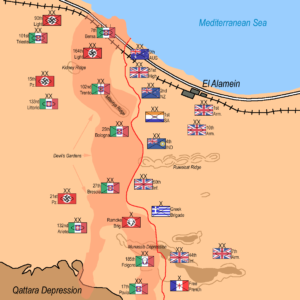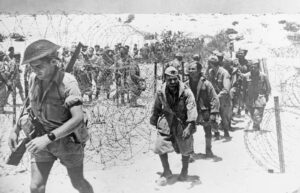In this week’s #ForgottenFriday we are exploring the Second Battle of El Alamein which, this Sunday (23rd), will be 80 years ago!
Leading up to the Battle:
The Second Battle of El Alamein (23rd October – 11 November 1942) during the Second World War took place near the Egyptian railway halt of El Alamein. The First Battle of El Alamein and the Battle of Alam el Halfa had prevented the Axis from advancing further into Egypt.
In August 1942, General Claude Auchinleck had been relieved as Commander-in-Chief Middle East Command and his successor, Lieutenant-General William Gott was killed on his way to replace him as commander of the Eighth Army. Lieutenant-General Bernard Montgomery (Monty) was appointed and led the Eighth Army offensive.

Montgomery
By mid-October 1942, Montgomery could deploy approximately double the number of men and tanks available to Rommel’s German-Italian army. The British also enjoyed the invaluable advantage of air superiority over the battlefield. Aware that an attack was imminent, Rommel had prepared his defences as best he could, sowing hundreds of thousands of anti-tank and anti-personnel mines along his front to slow any British advance. Rommel returned to Germany to recuperate from illness shortly before the British offensive was launched, command passing to a subordinate.
Monty’s plan comprised a diversionary attack to the south, spearheaded by Free French troops, while the main attack would come in the northern sector, close to the coast. The British would break into the Axis line and force them to counterattack. In the process, the British would wear down the enemy’s offensive capability.

On the night of 23rd–24th October, a barrage from more than 800 guns heralded the offensive; British sappers, followed by infantry and tanks, advanced to clear paths through the minefields. Although the Axis commanders were taken aback at the violence of the assault, the Eighth Army’s progress was painfully slow; the British armour failing to get to grips with the enemy. Rommel, meanwhile, mounted spirited counterattacks.
For a while it seemed that the Axis might bring the British offensive to a halt. The German minefields and accurate antitank fire produced a mounting toll of knocked-out British tanks. But progress by the infantry, especially the Australian and New Zealand Divisions, opened corridors through the Axis defences that the British could exploit!
On 2nd November, Rommel signalled to Hitler that the battle was lost. Although initially refused permission to retreat, Rommel began the withdrawal of his German units, leaving his Italian allies – who lacked motor transport – to be taken by the British.

Prisoners of War in Italian Closure, November 1942
By 4th November, the motorized elements of the Axis were in full retreat, and because of the sluggish British follow-up they were allowed to escape virtually unscathed. But this was of limited strategic importance because the British victory at El-Alamein was confirmed by Operation Torch, the Anglo-American landings in North Africa on 8th November.


